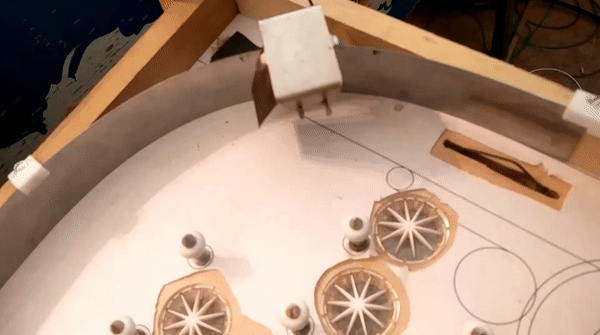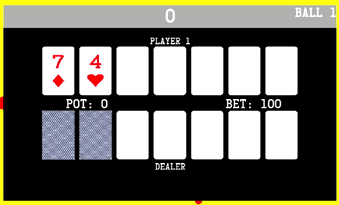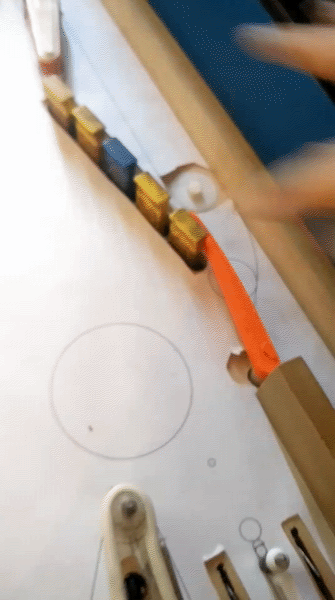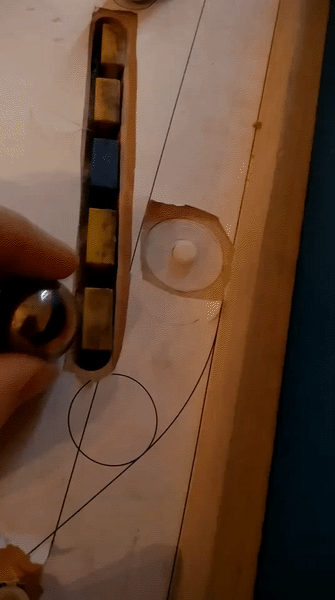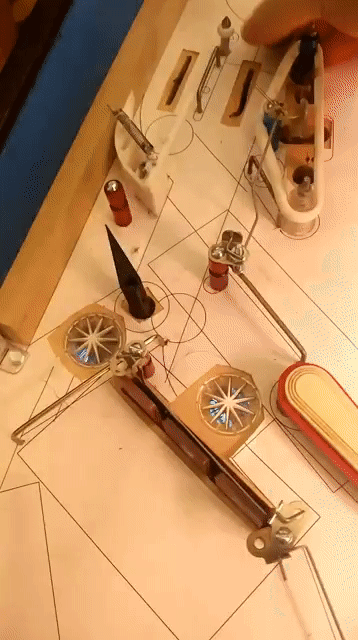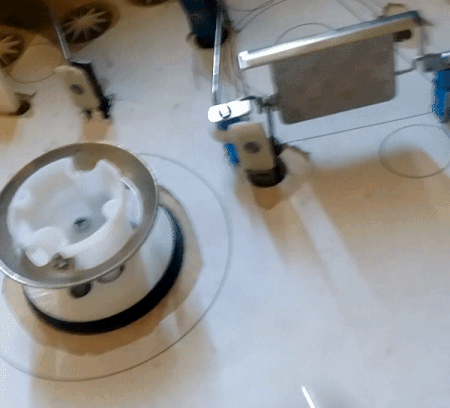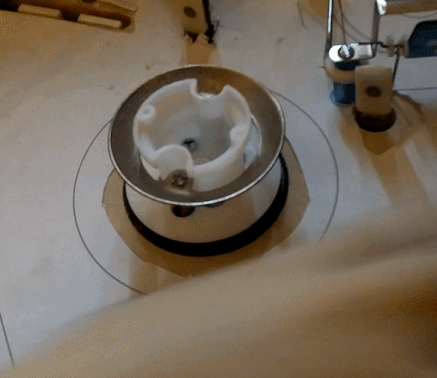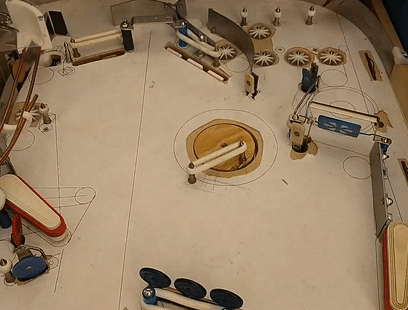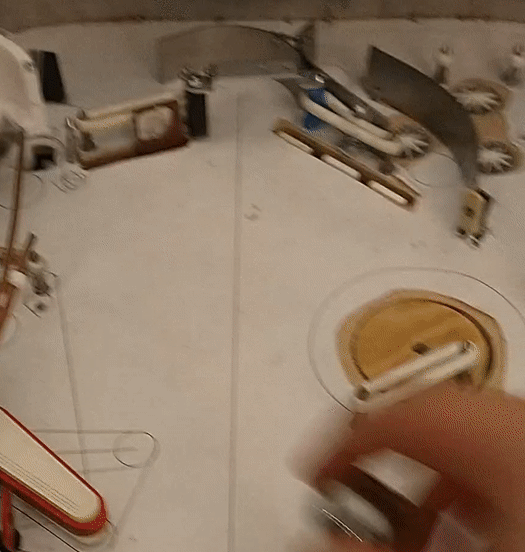With the gate figured out, I'm almost ready to tear the playfield down and start cutting my lexan covering. There's ones area I'm still not satisfied with though: the upper right area
 pasted_image (resized).png
pasted_image (resized).png
my original design for this was intended for it to be two offset rows of three lanes, using the shot behind the upper drops as the third upper lane. Like on EMs, you'd shoot up there, bounce around, and try to nudge into the lane you want, then fall down into the pops. But it isn't working out the way I wanted.
1. due to the path of the ball coming through the spinner, I had to remove the mini post I was going to have on the far right of the lower lane, so now balls tend to just roll off to the right instead of going over the rollover
2. there's only one pop bumper, and it's not directly below the lanes. you don't get balls going back up through the lanes much. instead, the ball rolls down to the pop, and gets shot back up to the area below the lanes, and then just falls back down to the pop again. Sometimes this can repeat 5x before the ball works its way around the pop and back into play. Not satisfying.
3. Due to the small size of the divider posts, it's much harder to nudge the ball where you want it than it would be on an older game, which would use 1/2" posts.
4. again, due to the way the ball comes in from the spinner, there's a gap between the rightmost post and the one way gate. When you shoot through the spinner, about 40% of the time, the ball bounces off the left gate and falls perfectly back through this gap, never entering any lane.
5. the lanes are so close to the top of the playfield that there isn't much room for the ball to move around. This also means that the exit of the lane behind the drops doesn't flow well since it just bangs into the top arch. I originally wanted it to shoot around the orbit.
6. because this playfield is longer than an EM, being in a whirlwind cab, the lanes are even farther away from the player, which makes it harder to figure out where the ball is going or nudge appropriately
Part of the small spacing is caused by the lane behind the drops, but I don't want to lose that shot since I want to use it for jackpots during multiball. At a minimum, I need to adjust the playfield somehow so that the ball can't escape the lanes on the right, but I'm considering reevaluating this area further...
A simplification of the lanes?
 pasted_image (resized).png
pasted_image (resized).png
Basically changing my two sets of three lanes into one set of four. This would solve the gap on the right issue. It should function ok, as long as the rightmost post/divider doesn't interfere with the spinner shot. There'd be no room or time for nudging, so this would have to be just a lane change affair. I'm not sure how much the ball would bounce around up there though, with the upper rail so close to the posts. Would you even have time to read the ball movement and try to change lanes before the ball had fallen into one?
The pop bumper will still feel a bit weird with the ball popping into that dead area repeatedly though. I'd like to move the pop bumper down some, but moving the entire bumper isn't something you can really do once you've cut its hole, so that'd have to wait for another whitewood...
Maybe get rid of the pop bumper completely?
Although I like having a pop bumper (especially one pop bumper, which recalls games like Stars, Meteor, or TNA), I'm not sure it fits this design that well. it tends to make play on the upper playfield very chaotic. If you don't hit the drop you're going for on your first try, you're out of luck because the pop bumper will pop the ball around and take out 2-3 drops before you can get control again, which is half your hand. I'd hoped it be more of a 'danger' off in the corner, but during play the ball tends to hit it any time it's up there.
 pasted_image (resized).png
pasted_image (resized).png
One thing I originally envisioned for this layout was that the center drops would be angled the other way, allowing you to bump the ball back towards the upper left flipper off them, but the spacing for that didn't work out. Adding a small rubber here might make the play up there more interesting, allowing you to bounce the ball back to the upper flipper. I could put a target on the back of that rubber too, to give the upper right flipper another target to shoot for. It was supposed to be able to hit the target on the upper left, under the ramp, but it turns out the flipper can't hit something that high up, so that target is basically useless.
Instead of lanes, I could try to do something like many williams EMs have? pasted_image (resized).png
pasted_image (resized).png
 pasted_image (resized).png
pasted_image (resized).png
A kickout hole with rubbers on either side to alternate the award. It's a fun area to play in, trying to nudge the ball back and forth to get it to land on the award you want. I'm not sure there's enough room for it, or what the awards could be though.
Or maybe something completely different. Get rid of the upper section completely. No more one way gates; the ball always does a complete orbit. Lots of other ways you could take this, but here's one idea I came up with: pasted_image (resized).png
pasted_image (resized).png
The shot next to the drops is still there, it's just redirected to feed the right orbit cleaner. Hopefully with this the ball could feed down the right to the inlane, or get caught be the magnet to feed the upper right flipper. The area below it could be an extra hard skillshot: plunge just to the beginning of the arch to arc the ball into that lane.
Or maybe that lane is also shootable via upper left flipper? The pop bumper would need to be removed to unblock the shot, but...
 pasted_image (resized).png
pasted_image (resized).png
Now you have two shots from the upper flipper. One feeds the left inlane to the lower left flipper, one feeds the right lane to the upper or lower right flipper, or shooter lane. I've always thought that was a cool idea, although it makes more sense on a more combo/flow game. Demolition man technically pulls it off, but the side ramp is so hard to shoot compared to the subway that everyone just goes for the subway. With equally easy/hard shots the flipper could act as a 'skill diverter' letting you intelligently set up more combos. Maybe that could still make sense for this game though, as long as the rules set up something for each lower flipper
These last two redesigns look a bit weird on first sketch, but there's a lot of room up there to tweak things and make them shoot smoothly. Having a large empty area like that feels weird to me though... As a designer I like to use up every single square inch of playfield, so having a large empty plastic like that seems like a waste, but maybe it's for the best?
Tomorrow I'm going to pull out the pop bumper and patch in some wood in the hole, and see how the upper area plays like that. Does it shoot better? Can an extra rubber there make the ball bounce back the way I'm thinking? Can the upper left flipper hit that rightmost shot? Can the upper right flipper hit that rubber?
I'll also try placing some more posts in the upper right area, see how far to the upper right I can put stuff without interfering with the spinner shot. I imagine if you get too close to the upper arch the ball is going to hit the post, since it's probably rattling around a bit as it meets the rail...
Thoughts? Any other cool ideas?


 Rochester, NY
Rochester, NY
 Merthyr Tydfil
Merthyr Tydfil
